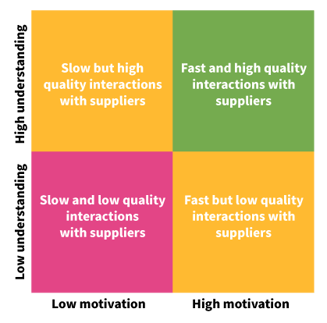Abstract
Solutions for Retail Brands (S4RB) are specialists working with retail private brands. Most CSR issues, challenges and initiatives require private brand teams to work with their suppliers in order to effect compliance or change. From working with our international clients and with information from multi-stakeholder initiatives such as Stronger Together this white paper is intended provide 11 practical tactics to engage suppliers specifically around the issues of modern slavery.
Preface
It was the hottest day of the year and I sat gazing out of the window of the top floor of John Lewis’s London office. Beautiful vista aside, the glass created a greenhouse; baking me and the other course delegates.
A bead of sweat dripped down my forehead
It’s laughable actually. Moaning about the heat as I sipped my morning espresso and eyed up the French Fancies presented beautifully in the centre of the table. After all, we were here to discuss, explore and understand how we and our collective organisations could address one of the darkest and most deplorable practices in our world. A practice that most believe a relic of a past age.
Modern slavery
An umbrella term for practices such as human trafficking, slavery, forced labour and domestic servitude. It is still a real and pressing threat with supply chains - globally and within the UK. Estimates put the number of men, women and children in slavery at 45.8 million1. The likes of India, Uzbekistan and Sudan may top the list. However, within our very own UK borders it is estimated that at least 11,700 people are subjected to these practices2.
Stronger Together is a multi-stakeholder initiative that brings together companies, labour providers, industry associations, NGOs and other key actors to address and help businesses tackle modern slavery. The Tackling Modern Slavery Global Supply chains course that I attended on that sweltering day in May is just one of many that they offer.
Present to understand how they could do their part, where an eclectic room of bright minds from Corporate Social Responsibility, technical and compliance backgrounds. They are the creators, the leaders and the change makers who will tackle modern slavery.
And me?
I want to help people in roles just like theirs land that change with maximum impact through successful supplier engagement. And on reflection, these are the 11 tactics for engaging suppliers with your tackling modern slavery strategy.
1Global Slavery Index 2016
2Global Slavery Index 2016
Introduction
Supplier Engagement is the level of commitment a supplier has to your brand, your values and your goals. These goals could be your short-term projects or taking suppliers with you on the journey for longer-term business objectives. Whether this be game changing private brands or the eradication of slavery.
The Three Pillars of Supplier Engagement
COMMUNICATION
Good communications ensure that retailers and suppliers are aligned as ‘One Team’ around a common objective. Clear goals. Clear policies.
SUPPORT
Support is an essential tool of supplier
engagement. Retailers need tools in place which make necessary information available to suppliers 24/7. Such as through a supplier self-help portal and online knowledge-base.
TRANSPARENCY
Transparency is one of the most important keys to supplier engagement, especially when it comes to performance. To collate information on non-conformance and to use this as part of a quarterly review will do little to change day-to-day conformance, whereas to collaborate with suppliers and share information on compliance as well as product performance and customer feedback in a transparent way will help align private brand teams and suppliers around a common brand goals and objectives.
The secret to Supplier Engagement
The secret to Supplier Engagement is motivation and understanding. As the diagram beside shows: motivate suppliers and they will complete it quickly. Grow their understanding and they will complete it to a high standard. Motivation and understanding are essential to getting more things done right, and right first time.
Practical Steps
1. Include suppliers on your tackling modern slavery strategic working group
One of Stronger Together’s first recommendations is to create a strategic working group to own the plan for addressing and mitigating the risk of modern slavery within your supply chain.
Inviting key representatives from your supply base opens a channel for valuable dialogue between you and your extended organisation. The chosen supplier representatives can act as an effective sounding board for any engagement initiatives, and help make sure that your communications are effective in driving measurable action.
2. Add “Engagement activity” to the agenda of the tackling modern slavery strategic working group agenda
Once created, your strategic group will agree upon a number of initiatives. You’ll all be keen to make an impact and get some successes under your belt to demonstrate the groups value. Engagement with your group’s initiatives is vital to conveying this value and gaining buy-in.
Engagement as a business practice needs to reflect engagement as an emotional state. Just like our emotions, feelings and thoughts are fluid and ongoing, so should be your engagement activities. Maintaining “Engagement activities” as an ongoing agenda idea will prompt you to review and adapt your initiatives to internal and external influences. In turn, this focus on continuous improvement will help you maximise people’s understanding of what you’re trying to achieve and how they play their part.
3. Map your supplier audience
Your supply base includes a hugely diverse number of organisation and individuals. Each possess differing cultures, processes and aspirations. Mapping the different segments of your supply base will mean you can tailor your messages to resonate most effectively. I’d recommend taking this further and recruiting tackling modern slavery champions from each supplier segment and creating a supplier forum to act as an extended arm of your strategic working group. This champions consortium will be the perfect cohort of people to help inform your activities, language, approach and progress.
4. Prioritise confirming and maintaining supplier contact information
Once you’ve mapped your supply chain, you need to make sure you can contact the right people. After all, you can craft the most beautiful emails with the most compelling messages, but if they don’t reach the right person at the right time, they have no value.
Ensuring that you collect – and most importantly maintain – accurate contact information for your suppliers is a corner stone to any supplier engagement initiative. Tackling modern slavery is no different.
5. Create a supplier communications calendar
Ongoing engagement on any topic needs consistent focus and attention. In the world where we’re bombarded by as many as 5,000 advertising messages a day, it’s tough to cut through the competing noise. Creating a communications calendar is an invaluable way of making sure that you’re balancing all the messages that you need to share across your business in a way that the end recipient can consume and actively engage with.
Your calendar can be anything from an Excel spreadsheet to Outlook calendar or even a wall calendar next to your desk. The important bit is visualising the “air traffic control” of your communication activities. Using different colours for each topic or supplier segment can also help you gauge balance at a glance.
6. Engage suppliers with your modern slavery policy early...
…and that’s more than just ‘acknowledging’ a PDF.
Reviewing policies is part of most retailer supplier onboarding processes. However, few go beyond simply making policies accessible and ask for them to be acknowledged. I strongly believe that acknowledgement alone rarely indicates understanding, let alone application.
Your onboarding policy should extend to requiring the supplier to apply your policy to their business and identify the strengths and weaknesses. Pro-actively seek suppliers to identify and track opportunities using techniques like “stop, start, continue” and incorporating progress into ongoing supplier scorecards.
7. Make it easy for suppliers and stakeholders to share experiences and best practice
Communication should go beyond a one-way broadcast of retailer policy and vision. Creating forums and opportunities for suppliers to openly share their experiences and successes of tackling modern slavery can help leverage the knowledge of ‘the crowd’ to tackle common issues with limited amounts of your resource.
You will want to assign key people from your organisation to moderate and curate conversations to extract the most value for online discussion spaces. Going beyond, you could share stories from within your own company that draw from experiences from your buyers, HR and technical teams. This activity not only generates conversation amongst your suppliers but most importantly demonstrate the value that your whole organisation place on tackling modern slavery.
The benefits will extend beyond the here-and-now. If the right forums allow suppliers to share information this can include an element of ‘horizon’ scanning where they can also share information or concerns about emerging issues which may, for example, be market or geography specific.
8. Recognise the importance of not always being in the conversation
Tackling modern slavery is a sensitive subject – I’m surprised it’s taken me until now to raise this under the topic of communicating about it. You may find that the candid conversations you crave to get below the surface is not forthcoming when you’re in earshot.
Being conscious of this and setting up forums and opportunities for your suppliers to discuss the topic of modern slavery without you will provide an important and valuable channel for information.
9. Share accessible, digestible and interactive information and training
Beyond your policy document, you need to create a foundation of supporting information targeted at each individual segment. This content should go beyond ‘what is to required’ to ‘why it is’ and ‘what it means to me’ for each role. Considering language, literacy and technology is key. Assessing this within your supplier mapping exercise will help you decide the most appropriate channel or platform to share.
Beyond the tackling modern slavery initiative, consider where it’s prudent to reference your policy and activities. By utilising consistent branding throughout your organisation’s materials when referencing it, you can effectively support the emending your approach to tackling modern slavery as an integral and ingrained part of your company culture. It will simply become the default - “the way you do things around here”.
We leverage the concept of supplier self-help in a broad range of scenarios to enable and empower suppliers as covered in the introduction on the three pillars of supplier engagement – the pillar of support. This approach is cost effective for the retailer but also efficient for the suppliers and makes the information available on-demand, 24/7.
10. Be transparent on performance and non-conformance
I’m a firm believer in transparency and in the power of making performance tangible. In the business context, I see this work best using engaging, online performance dashboards. Creating dashboards that set clear expectations on what you what from your suppliers, where they currently are is a incredibly important motivational too. Importantly, you must be clear on what they need to do to improve and how this can be done. Part of the solution for tackling modern slavery is working with suppliers to address non-conformances as opposed to simply de-listing them. This simply moves the problem around.
A supplier once put it very well: “Tell me what good looks like. Tell me how I am doing. And tell me how to get better”. Transparency goes to the first two of these and if integrated with the resources, information and training this delivers both motivation and understand to effect change.
11. Spend time monitoring the outcomes of your engagement activities
The activities that you deliver are only outputs. They, in themselves, will not necessarily make any impact on modern slavery. Therefore, it’s vital that you set clear goals and establish key performance indicators (KPI’s) to measure your progress against. This will help you see if your engagement activities – your outputs – are delivering measurable results – your outcomes. And it is these outcomes, that will add true weight to your public modern slavery statement.
In my experience, the most compelling business outcomes have a commercial value assigned to them. In ethical areas this can be particularly difficult. However, you could consider working with your PR team to assign commercial value to the positive and negative coverage associated with tackling modern slavery. The commercial value is arguably indirect but perhaps enough to pique the interest and engagement that you need with key commercially-orientated decision makers.
In closing
This list is by no means conclusive or perfect for every organisation. It’s important that your approach matches your company and it’s own unique culture.
If you’re interested in learning more about tackling modern slavery and engaging your key stakeholders, I’d strongly recommend you start with Stronger Together, www.stronger2gether.org. Their affordable and actionable range of courses can add value to anyone at any business.
After all, tackling modern slavery is not just the responsibility of CSR or technical. We all must do our part. Even a fluffy communications professional like me.




